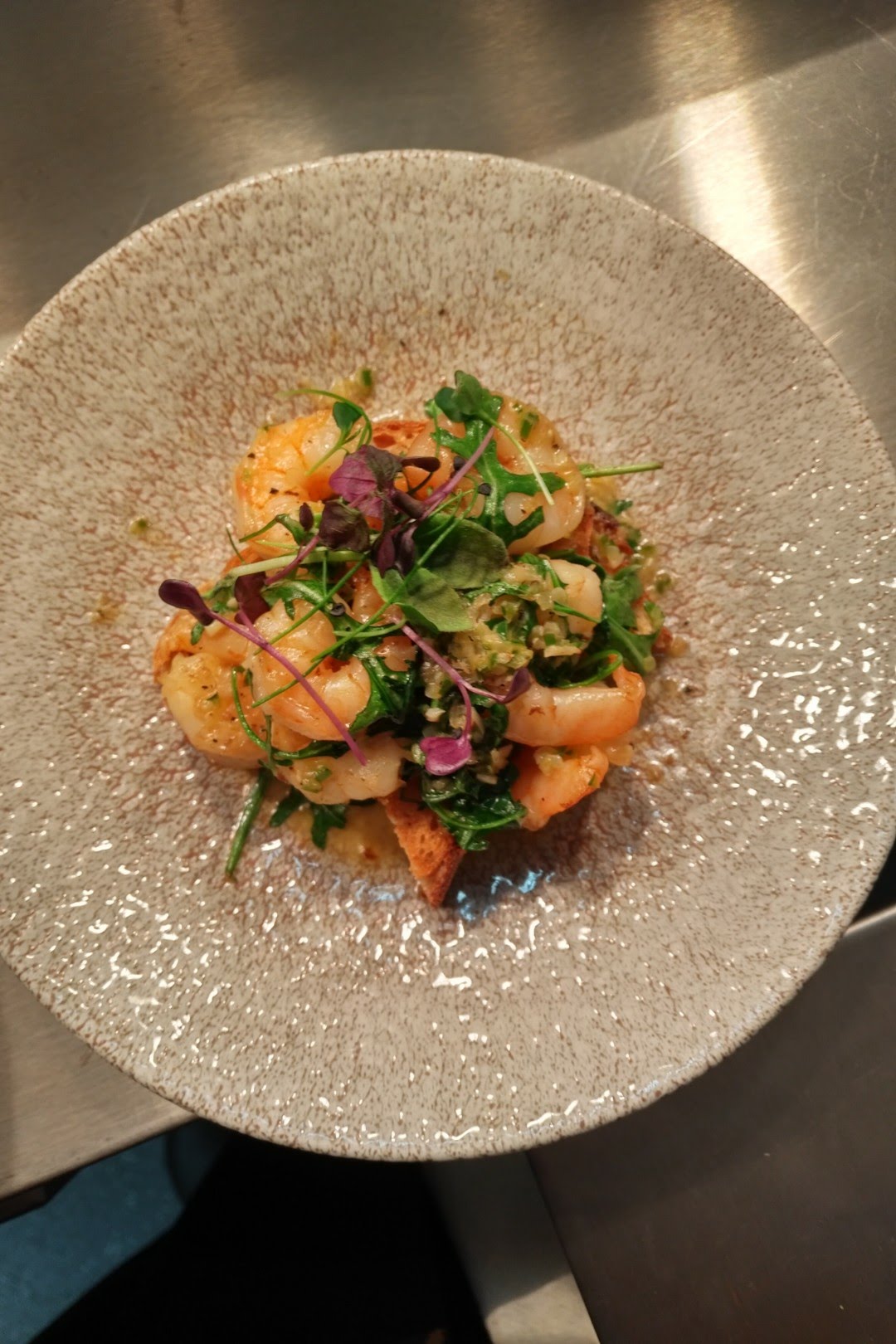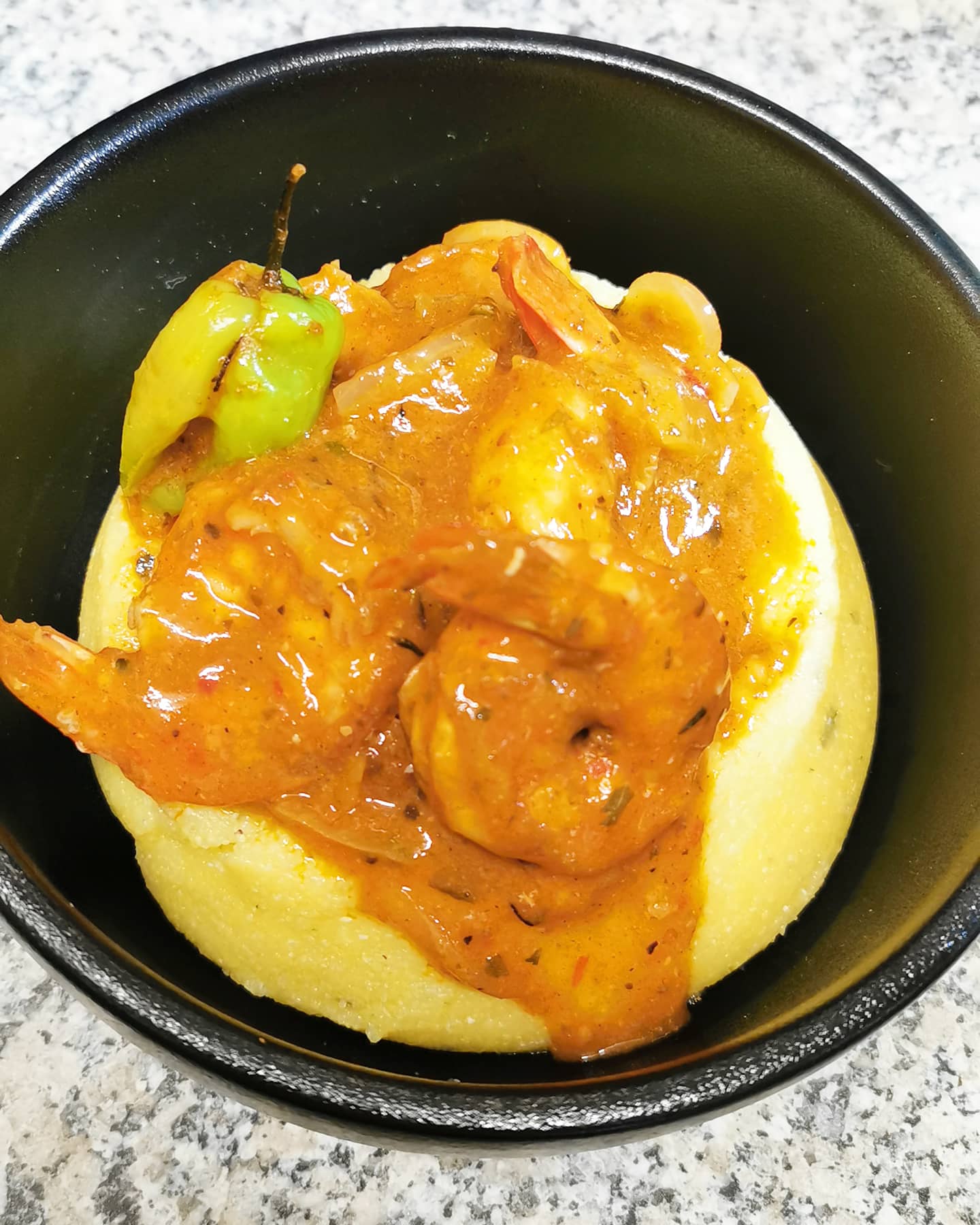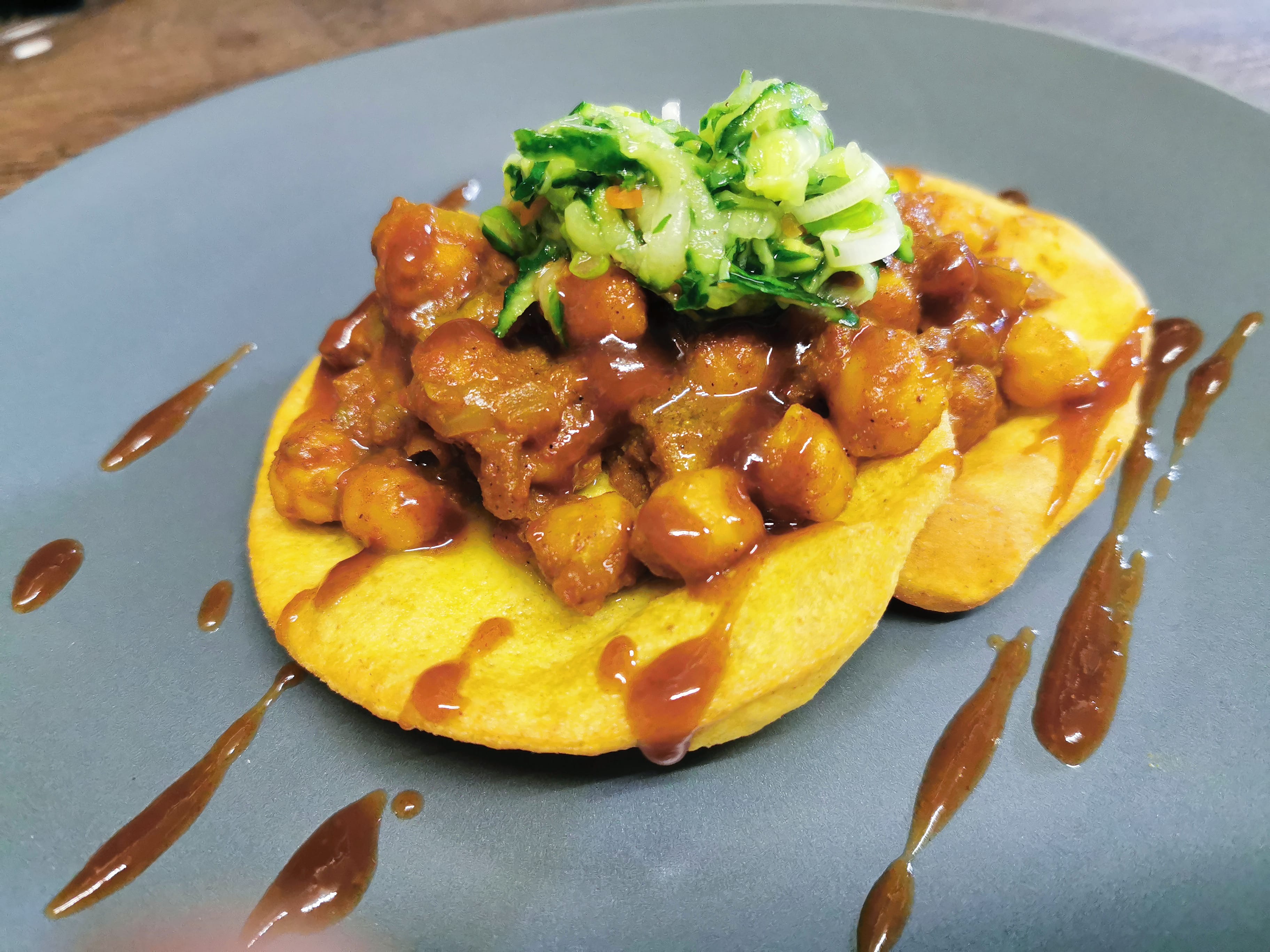Brine recipe
-
1ltr boiling water
-
2ltrs cold water
-
300g salt
-
200g brown sugar
-
2 whole scotch bonnet/chilli
-
1 onion roughly chopped
-
5 peeled garlic cloves, cut in half
-
10 pimento seeds
-
10 whole pepper corns
-
1 cinnamon stick
-
5 star anise
-
5 bay leaves
-
3 sprigs of thyme
Bring 1ltr of water and all the ingredients up to boil and simmer for 10 minutes. Add to the cold water and keep until ready to use.
Missing fried chicken? Use the brining recipe and then this seasoned flour recipe for fried chicken
BBQ glaze
This is a recipe I use when I do BBQs. It’s a straightforward finishing glaze when barbecuing, adds another level of flavour and spice.
-
250g Dark muscovado sugar
-
200ml Red wine vinegar
-
1 finely chopped onion
-
100ml Tomato ketchup
-
50ml Dark rum
-
1 tablespoon Worcestershire sauce
-
1 tablespoon tabasco sauce
-
1 tablespoon hot smoked paprika
-
1 teaspoon garlic granules
-
1 teaspoon coarse black pepper
-
1 teaspoon salt
In a saucepan heat the sugar, vinegar and onions in a pan. You only need to heat it until the sugar fully dissolves. Remove from the heat and whisk in the remaining ingredients apart from the dark rum which you will add once cooled. Store in the fridge until the sun comes out. If you have a garden do not invite people to come over for a BBQ. Social distancing rules apply.
Seasoned flour
When you plan on making fried chicken, try this seasoned flour. Then let me know what you think. Thank me later!
-
500g Plain flour
-
1 tablespoon salt
-
2 tbl sp vegetable stock powder
-
1 tbl sp dried thyme
-
1 tbl sp dried basil
-
1 tbl sp dried parsley
-
½ tbl sp dried oregano
-
2 tbl sp ground black pepper
-
4 tbl sp ground white pepper
-
4 tbl sp hot paprika
-
4 tbl sp garlic powder
-
4 tbl sp onion powder
-
2 tbl sp ground ginger
If you have a spice grinder, great. If you don’t a food processor will do. Add all the coarse dry ingredients to the grinder except the flour. You’re trying to achieve a fine powder to incorporate into the flour. Once all ground mix into the flour. Store in an airtight container.
When you’re ready to make some fried chicken, you want to place the chicken in some buttermilk. Buttermilk is a great tenderiser because of the acidity. It also helps with the coating of the flour and chicken. But you need to thin it down to a double cream consistency using water. Place your pieces of chicken in the buttermilk for a few hours. Pass through the seasoned flour, shake off the excess and deep fry your chicken. Fry the chicken until golden brown and finish in the oven to cook through. In chicken shops they use pressure fryers and vary the cooking temperatures, starting high at around 190c then dropping to around 140c to finish cooking.
 Pan fried King prawns, wilted spinach, white wine, chili and garlic sauce
Pan fried King prawns, wilted spinach, white wine, chili and garlic sauce
Here is a dish I’ve done in a few places I’ve worked. I often served it as a starter or tapas style. Its quick and easy. Serve with toasted sourdough bread on the side to soak up the sauce. You can also try it with mash or rice.
You can use prawns with the shell on or off, but don’t use cooked prawns for this dish as they will be tough.
Prawns are really easy to cook. Some prawns come ready prepped with tails on and de-veined. Quite often frozen, which is fine. If you are going to use frozen prawns thaw them out in the fridge overnight.
Serves 2 (8 prawns each)
-
16 tiger prawns, tails on, de-veined
-
5 Garlic cloves, finely chopped
-
½ Chilli finely chopped
-
2 shallots or 1 small onion, finely diced
-
5 Sprigs of Parsley, chiffonade including stalks
-
100g baby spinach or rocket
-
2 slices of toasted sourdough
-
100ml White wine
-
75g Butter
-
1 Tablespoon rapeseed oil
-
4g Maldon sea salt
-
3g Cracked black pepper
-
-
Put a large frying pan on a medium heat with the oil. Allow the oil to slightly smoke. Place all the prawns into the pan, making sure they are all flat. Season with salt and pepper.
-
Add your finely diced onion, garlic and chilli allow to cook for 1min. Do not let them burn. Allow the prawns to get some good colour before turning over (2-3 mins). Once one side has a good caramelisation, turn the prawns over, season with salt and pepper.
-
Carefully add you wine, allow to cook out for 1-2mins. Allowing the wine to reduce by half before adding the butter.
-
Once the butter has been added and incorporated, wilt the spinach or rocket with the prawns, carefully tossing. Finish off with your chiffonade of parsley. Serve on toasted sourdough and drizzle the sauce over
-
If you have a probe the core cooking temperature you need is 75c
 Prawn rundown (serves 2)
Prawn rundown (serves 2)
Also known as shrimp rundown is a popular Caribbean dish where the main protein is cooked in coconut milk based sauce. Prawns can be replaced with any shellfish or fish or a mixture of both. Here is a prawn version with a seafood and vegetarian dish to follow.
-
18 King prawns or Tiger prawns 26/30 or 16/20 Headless, shell off, tails on and deveined
-
1 large onion, diced
-
2 cloves of garlic, finely chopped
-
½ tablespoon coconut oil
-
1 tablespoon dry jerk seasoning
-
2 teaspoons ground cumin
-
1 scotch bonnet, cut in half
-
1 can chopped tin tomatoes
-
1 can coconut milk
-
1 vegetable stock cube or stock pot
-
1 sprig of thyme
-
1 teaspoon cracked black pepper
-
2 Bay leaves
-
Salt to taste
-
-
If you’re using prawns that are frozen, defrost in the fridge overnight. Marinade prawns for a few hours before cooking.
-
Drain off any excess water and season the prawns with dry jerk seasoning.
-
In a large frying pan, heat the coconut oil on a high heat and sear prawns on both sides so they have a nice caramelised colour, 30secs each side. Remove prawns and set aside.
-
Reduce the heat to a medium flame. Add your onions, garlic, ground cumin and thyme to the pan and sweat without colour.
-
Add chopped tomatoes, coconut milk, cracked black pepper, bay leaves and scotch bonnet; bring to the boil.
-
Add your stock cube/pot and mix through until dissolved.
-
Allow the sauce to simmer and reduce by a ⅓ before adding the prawns.
-
Once the prawns are in the sauce, they will only need 6-8mins to cook. You don’t want to overcook the prawns as they will shrink and toughen up. Taste for seasoning and correct by adding salt and pepper. If you have a probe, the prawn core temperature needs to reach 75c.
-
Serve with plain white rice, mash potato or as I did with Bajan cou-cou. The recipe can be adapted to incorporate vegetables such as diced peppers and green beans.
TriniDoubles 
'Trini doubles' are the ultimate street food staple in many Caribbean islands, especially Trinidad & Tobago. I ate so many in Barbados from Lisa's doubles & roti, in Worthing, next to Jacks Bar.
These lightly spiced fried flatbreads (bara) topped with curried chickpeas, a spicy yet cool cucumber chutney and tamarind sauce. If you’re vegan, this is a must try. Even if you’re not vegan, this may sway you..not quite turn vegan but to eat more vegan or vegetarian food.
I cannot remember the wield of this recipe but when I make them again, I’ll add to the recipe. But it does make a couple days’ worth of mix.
Bara (flatbread)
-
400g Plain flour (you will need more flour while kneading and rolling the dough so have a container ready)
-
8g Dried yeast
-
1tsp baking powder
-
1 teaspoon Garam masala
-
1 tsp Ground cumin
-
1 tsp Garlic granules
-
2 tsp salt
-
1 tsp ground white pepper
-
½ tsp saffron
-
1 tsp turmeric
-
1 tablespoon sugar
-
300ml lukewarm water
(oil to stop the dough sticking while resting and oil for frying)
-
In a measuring jug, measure out 300ml of lukewarm water, add the saffron and mix allowing to infuse the water. Set aside.
-
In a large bowl combine all of the dry ingredients and thoroughly mix. Make a well in the centre and slowly incorporate the infused saffron water.
-
The aim is to form a soft dough before kneading. If the mix is too wet or sticky add a bit more flour.
-
Once you’ve formed the dough, you need to knead the dough for 1 minute before resting. Flour your surface when kneading the dough and form a ball. Place a touch of oil on the dough and rub all over, this is to prevent it from sticking while proving. Place back in the bowl, clingfilm and place in a warm place and allow the mix to double in size.
-
Once doubled in size, we need to knock it back. So, push in the center and allow the air to disperse. On a floured surface, tip the mix out and knead.
-
You will need a floured tray for the next step. Weigh out 30g balls of dough and place on the floured tray, spaced out. We’re going to allow the dough balls to prove again and they will expand. Once all the mix is portioned out allow to prove for 30mins.
-
The next step you will need more flour to hand. Always rub flour on your rolling pin and have enough flour on the surface as the dough will stick.
-
On a floured surface, roll out the dough to around ½cm thickness and around the size of your palm, keeping the dough as round as possible. Do this in batches. If you have greaseproof or silicone paper to layer the rolled-out dough, great.
-
In a large frying pan, heat your oil on a medium heat. If you have a probe because you’re foodie the oil needs to reach around 180c. You can test the temperature by dipping the rolled-out dough into the oil, the oil should immediately start to bubble up. Once up to temperature, fry the dough on each side for about 20secs.
-
Place on kitchen roll and continue frying the dough.
-
Serve by placing two of the bara’s on a plate, top with the curried chickpeas (Chana), cucumber chutney and a bit of tamarind sauce
Cucumber chutney (Pickle for doubles)
The refreshing yet slightly spicy accompaniment to the doubles. It’s a really easy pickle to make.
-
1 cucumber
-
1 garlic clove
-
½ zest of lime
-
½ lime juice
-
½ scotch bonnet
-
5 sprigs coriander
-
Freshly ground black pepper to taste
-
Pinch of salt to taste
Finely chop the garlic, scotch bonnet (keep the seeds if you want a bit more heat), zest half a lime and squeeze half a lime in a bowl.
Grate the cucumber, and chiffonade the coriander including the stalks. Add a pinch of salt and freshly ground black pepper both too taste
Mix and serve with your Trini doubles.
Curried chickpeas (Chana)
A tweaked version of the classic chana for doubles, with a few more extra ingredients. This particular curry isn’t meant to be water or thin. Its thicker than a normal curry as it holds better with the bara (flatbread). But, you can make it to your own taste. Thin it down to make it saucier, if you want to eat it with rice and a naan bread
-
2 Cans chickpeas (Not drained)
-
2 Large potatoes (King Edward, Maris piper preferably). Peeled and cut in to 1cm dice left in water to stop discolouring.
-
1 Large onion, finely chopped
-
4 Garlic cloves, finely chopped
-
2 Sprigs of thyme
-
1 Scotch bonnet, finely chopped
-
½ Bunch of coriander, chiffonade including stalks
-
2 Tablespoon rapeseed oil
-
1 Vegetable stock cube/pot
-
1 Tin chopped tomatoes
-
2 Tablespoons Medium curry powder
-
2 Teaspoon turmeric
-
1 Tsp ground cumin
-
1 Tsp garam masala
-
1 Tsp ground black or white pepper
-
1 Tsp mixed spiced
-
1 Tsp ground pimento (allspice)
-
150ml water
-
In a large saucepan or pot, lightly toast all your spices over a medium heat, stirring constantly not allowing spices to burn. You will start to smell the spices and white smoke will omit when the oils start to release. Don’t toast any further.
-
Add your oil, onions, garlic to the pan and sweat them off. You may want to add some water as everything is cooking as it will thicken very quickly. The aim is to make a paste
-
Add your tin of chopped tomatoes, stock cube, scotch bonnet pepper (whole), thyme. Making sure the stock cube full dissolves and doesn’t stick to the pan. You can dissolve your stock cube in a cup of boiling water. Cook for a few minutes.
-
Add your chickpeas including the water. The water has flavour. Bring everything to the boil and allow to simmer for 30mins, occasionally stirring.
-
Taste for seasoning. Just remember this still needs cooking and will reduce, so you may want to correct the seasoning nearer to the end with salt, pepper and maybe more chili.
-
Add your potato and some of the water if the curry is already thickened. It should be watery for the moment as the potatoes will thicken the sauce. Once the potatoes are cooked and the sauce has thickened, correct the seasoning. Skim off any excess oil that has formed on top. Stir through the coriander and serve with your bara.
Fish & prawn rundown (Serve 3-4)
Just like the prawn version this has some lovely chunks of fish in it. Any flaky white fish or salmon can be used in this recipe.
-
10 King prawns or Tiger prawns 26/30 or 16/20 Headless, shell off, tails on and deveined
-
260g Salmon fillet, skinless, cut into 1.5inch chunks
-
260g Cod or haddock loin, skinless, cut into 1.5inch chunks
-
2 large onions, diced
-
4 cloves of garlic, finely chopped
-
1 tablespoon coconut oil
-
2 tablespoon dry jerk seasoning
-
3 teaspoons ground cumin
-
2 scotch bonnet, cut in half
-
2 cans chopped tin tomatoes
-
2 cans coconut milk
-
1 fish stock cube or stock pot
-
3 sprigs of thyme
-
4 bay leaves
-
1 teaspoon cracked black pepper
-
Salt to taste
-
-
If you’re using prawns that are frozen, defrost in the fridge overnight. Marinade prawns for a few hours before cooking.
-
In separate containers season the fish with some of the dry jerk seasoning. Drain off any excess water and season the prawns with dry jerk seasoning. Allow to marinate for a few hours prior to cooking.
-
In a large sauté pan or pot, heat the coconut oil on a high heat and sear prawns on both sides so they have a nice caramelised colour, 30secs each side. Remove prawns and set aside.
-
Reduce the heat to a medium flame. Add your onions, garlic, ground cumin and thyme to the pan and sweat without colour.
-
Add chopped tomatoes, coconut milk, cracked black pepper, bay leaves and scotch bonnet; bring to the boil.
-
Add your stock cube/pot and mix through until dissolved.
-
Allow the sauce to simmer and reduce by a ⅓ before adding the fish. Allow to cook for 3-4mins before adding the prawns
-
Once the prawns are in the sauce, they will only need 6-8mins to cook. You don’t want to overcook the prawns as they will shrink and toughen up. Taste for seasoning and correct by adding salt and pepper.
-
Try not to over stir the stew to prevent the fish from breaking.
-
If you have a probe, the prawns and fish core temperature needs to reach 75c.
-
Serve with plain white rice, mash potato or as I did with Bajan cou-cou. The recipe can be adapted to incorporate vegetables such as diced peppers and green beans.
 Pan fried King prawns, wilted spinach, white wine, chili and garlic sauce
Pan fried King prawns, wilted spinach, white wine, chili and garlic sauce Prawn rundown (serves 2)
Prawn rundown (serves 2) 
